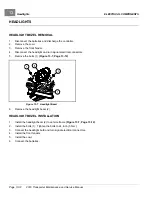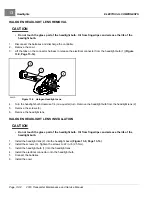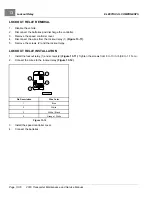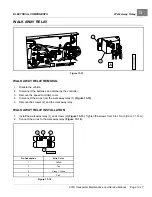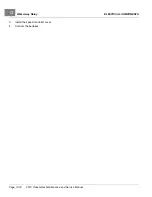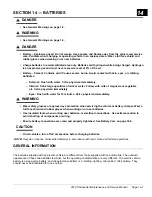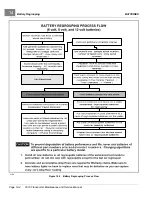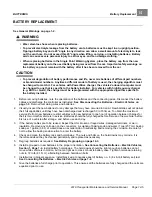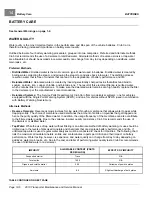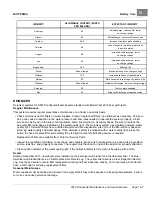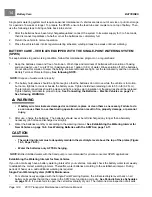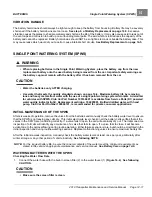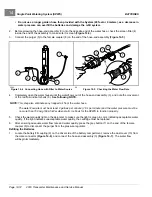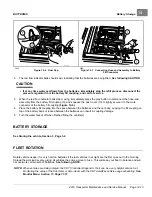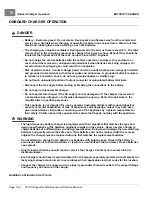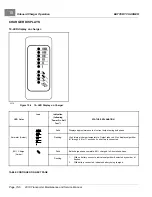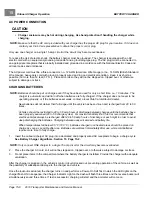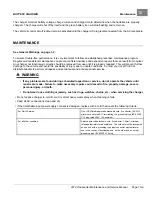
14
Battery Care
BATTERIES
Single point watering systems will require seasonal maintenance if vehicles are taken out of service or put into storage
for a period of 6 weeks or longer. To prepare the SPWS, ensure the feed tube and coupler are on top of battery. Then,
use the following steps to bring vehicle back into service:
1.
After the batteries have been fully charged/equalized, connect the system to its water supply for 3 to 5 seconds,
then disconnect regardless of whether or not the batteries are completely full.
2.
Return the vehicle to normal operation.
3.
Place the vehicle back into its regular watering schedule, waiting at least one week until next watering.
BATTERY CARE – VEHICLES EQUIPPED WITH THE SINGLE-POINT WATERING SYSTEM
(SPWS)
To keep batteries in good working condition, follow this maintenance program on a regular basis:
1.
Keep the batteries clean and free of corrosion. Wash tops and terminals of batteries with a solution of baking
soda and water; use 1 cup (237 mL) baking soda per 1 gallon (3.8 L) of water. Rinse solution off of the batteries.
Do not allow this solution to enter the battery. Be sure terminals are tight. Let the terminals dry and then coat with
Battery Terminal Protector Spray.
See following NOTE.
NOTE:
Dispose of waste water properly.
2.
The battery hold-downs should be tight enough so that the batteries do not move while the vehicle is in motion,
but not so tight as to crack or buckle the battery case. Tighten hold-down retaining nuts to 55 in·lb (6.2 N·m).
The terminal connections should be clean and tight, and any worn insulation or frayed wires should be replaced.
Tighten battery terminals to proper torque.
See Connecting the Batteries – Electric Vehicles on page 1-4.
See following WARNING.
WARNING
• If battery wire terminals are damaged or corroded, replace or clean them as necessary. Failure to do
so can cause them to overheat during operation and can result in fire, property damage, or personal
injury.
3.
After use, charge the batteries. The batteries should never be left discharged any longer than absolutely
necessary (do not leave discharged overnight).
4.
Water the batteries monthly or according to the watering interval.
See Establishing the Watering Interval for
New Vehicles on page 14-8. See Watering Batteries with the SPWS on page 14-11.
CAUTION
• The watering interval must adequately maintain the electrolyte level above the top of the plates (Figure
• Water the batteries only AFTER charging.
NOTE:
Bottled distilled water, with the hand pump is recommended for private consumer SPWS applications.
Establishing the Watering Interval for New Vehicles
If you do not already have a battery watering interval for your vehicles, manually check the battery water level weekly
to establish the correct watering interval. Thereafter, water batteries according to the established interval. During
periods of heavy use, add additional watering as required.
Single-Point Watering System (SPWS) Maintenance
1.
For vehicles newly equipped with the Single-Point Watering System, the initial electrolyte level check on all
battery cells verifies that all the valves in the SPWS are functioning correctly.
See Periodic Service Schedules
If a valve fails to open, the cell will eventually dry out. The initial one-time inspection of all cells
Page 14-8
2019 Transporter Maintenance and Service Manual
Summary of Contents for TransPorter 4
Page 2: ......
Page 271: ...ELECTRIC MAIN HARNESS Wiring Diagrams Electric Main Harness 18 ...
Page 272: ... Page intentionally left blank ...
Page 273: ...ELECTRIC INSTRUMENT PANEL HARNESS Wiring Diagrams Electric Instrument Panel Harness 18 ...
Page 274: ... Page intentionally left blank ...
Page 275: ...ELECTRIC ACCESSORIES HARNESS Wiring Diagrams Electric Accessories Harness 18 ...
Page 276: ... Page intentionally left blank ...
Page 282: ...NOTES ...
Page 283: ...NOTES ...
Page 284: ...NOTES ...
Page 285: ......
Page 286: ......

